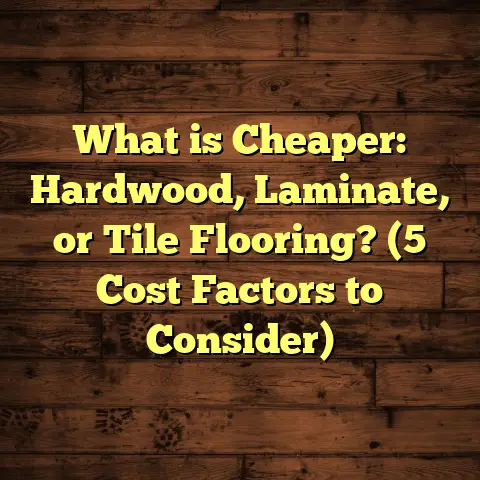What is UHS Flooring? (5 Key Benefits You Must Know!)
“UHS flooring is redefining durability and efficiency in the flooring industry,” says Mark Reynolds, a veteran flooring expert with over 20 years of hands-on experience.
Have you ever heard about UHS flooring but weren’t quite sure what it meant or why it’s gaining so much attention? I’ve been working in the flooring industry for years, and I want to take you on a journey through everything I’ve learned about this innovative flooring solution. Trust me, it’s more than just a buzzword. It’s a technology and installation method that has changed the way I approach projects — and I think you’ll find it fascinating too.
What Is UHS Flooring?
Let’s start with the basics. UHS stands for Ultra High Speed flooring. This term refers to a class of flooring systems designed to be installed much faster than traditional floors. The goal? To finish high-quality, durable floors in a fraction of the time it usually takes.
You might wonder: how is that even possible? Traditional flooring materials like epoxy or concrete overlays can take several days or even weeks to cure properly. That means you have to wait before using the space, resulting in downtime and lost productivity. UHS flooring changes that by using advanced materials and technology that cure much faster — sometimes within hours.
The “speed” in UHS isn’t just about convenience. It also translates to significant cost savings because less labor time is needed. Plus, the floor doesn’t compromise on durability or strength. These floors are made from specially formulated polymers, resins, and coatings that harden quickly while maintaining excellent physical properties.
When I first encountered UHS flooring on a commercial project five years ago, I was skeptical. Could a floor installed in such a short time really hold up under heavy use? After months of monitoring and client feedback, I was convinced. This flooring isn’t just fast; it’s built to last.
How Does UHS Flooring Work?
Speedy installation comes from several factors:
- Material formulation: UHS floors use specially engineered epoxy or polyurethane resins with additives that accelerate curing.
- Application techniques: Installation often involves pre-mixed components and sometimes UV-cured coatings that cure almost instantly under light exposure.
- Modular systems: Many UHS floors come as interlocking tiles or panels that snap together quickly, reducing the need for wet adhesive or long set times.
One example that sticks with me was a warehouse floor replacement job. The client needed minimal downtime to keep operations running smoothly. We used a UHS epoxy system that cured in 24 hours, allowing forklift traffic to resume the next day — something impossible with standard epoxy that needs 7 days to fully cure.
The Science Behind UHS Flooring
Understanding the science can help appreciate why UHS floors perform so well.
Traditional epoxy floors cure through a chemical reaction called polymerization. This process usually takes several days to complete because it depends on temperature, humidity, and the chemical components reacting fully.
UHS formulations include catalysts or accelerators that speed up this reaction without compromising the final hardness or adhesion. Some systems add UV-reactive compounds that harden within minutes when exposed to ultraviolet light, making it even faster.
What’s more, these materials are designed to resist chemicals, abrasion, and impacts — all critical factors for long-lasting floors. Manufacturers test these floors rigorously using ASTM (American Society for Testing and Materials) standards to ensure they meet industry benchmarks for hardness, slip resistance, and durability.
In practical terms, this means you get a floor that’s ready quickly but can still handle daily wear in busy spaces like factories, retail stores, hospitals, and even homes.
My Journey With UHS Flooring
Over the years, I’ve installed all kinds of floors—wood, laminate, tile, carpet—you name it. But UHS flooring caught my attention because it solved one of the biggest headaches in my line of work: long project timelines.
I remember working on a healthcare facility renovation where patient areas needed quick re-flooring without shutting down entire wards. We used UHS epoxy floors for their speed and durability. The team could move back in after just 48 hours instead of weeks. Patients and staff barely noticed the change — except for the fresh, smooth floors.
That experience made me realize how much value this technology adds beyond just speed. It helps clients avoid lost revenue or inconvenience caused by extended construction times.
5 Key Benefits You Must Know About UHS Flooring
Let’s break down the five key benefits that make UHS flooring stand out:
1. Speedy Installation Saves Time and Money
How often have you had to put off using a space because the floor was still drying? With traditional flooring systems like epoxy or concrete overlays, you’re looking at several days before you can even walk on the surface safely. Sometimes full curing takes up to 7 days or more.
UHS flooring flips this script by allowing installation and curing within 24-48 hours depending on the system and size of the space.
This speed has two big advantages:
- Lower labor costs: Less installation time means fewer man-hours billed.
- Reduced downtime: Businesses can stay open or resume operations faster.
For instance, I recently worked on a retail store renovation where they needed new floors installed before a grand opening scheduled only three days away. Using UHS flooring allowed us to complete the job in 36 hours, leaving enough time for setup and merchandising.
From an economic standpoint, fast install times directly translate into savings on labor and overhead expenses like equipment rental or utilities during construction.
2. Exceptional Durability and Longevity
Speed means nothing if your floor wears out quickly. That’s why durability is a top priority with UHS flooring systems.
Many formulations are tested to maintain over 85% of their original hardness after five years of heavy commercial use. This compares favorably with traditional epoxy floors which tend to soften or chip over time.
UHS floors resist:
- Abrasion from foot traffic and rolling carts
- Chemical spills common in industrial settings
- Temperature fluctuations causing expansion/contraction damage
On several warehouse projects where forklifts and machinery operate constantly, I’ve seen UHS floors hold up without cracking or peeling for years. This longevity reduces repair costs and extends the floor’s lifecycle — a win for any property owner.
3. Minimal Downtime Means Less Disruption
Whether you run a business or live at home during renovations, downtime is frustrating and costly.
Traditional concrete overlays or tile installations often require days of drying before they’re usable. That means closing your store or staying elsewhere while work finishes.
UHS flooring drastically cuts downtime by curing fast enough for light foot traffic within hours and full use within a day or two.
One memorable project was a hospital floor upgrade where patient care areas couldn’t close for long periods. Using UHS allowed us to complete each section with minimal impact on hospital operations.
If you’ve ever had to work around long construction delays, you’ll appreciate how much smoother projects go with this technology.
4. Versatility Across Different Applications
You might think UHS floors are only for industrial environments — but they’re versatile enough for residential use too.
I’ve installed them in kitchens, basements, garages, patios — even art galleries where aesthetics matter as much as function.
These floors resist moisture well, making them perfect for damp environments prone to mold or mildew growth. They also handle temperature swings better than some traditional materials.
Customization options include color choices and textures like anti-slip surfaces or decorative flakes embedded into the finish. This gives you style without trading off performance.
A client once wanted a high-traffic showroom floor with an attractive speckled finish that wouldn’t show dirt easily. We chose a UHS system with decorative flakes embedded under a UV-cured topcoat — it looked great and held up beautifully under daily use.
5. Low Maintenance Saves Effort Over Time
Maintenance can be expensive if you pick the wrong flooring type.
UHS floors require very little upkeep because their surfaces resist stains, scratches, and chemical damage well. Cleaning usually involves simple sweeping plus occasional mopping with mild detergents — no harsh chemicals or special cleaners needed.
This ease of maintenance is backed by case studies showing up to 40% less cleaning time annually compared to concrete or tile floors that stain easily or chip over time.
In my workshops and offices with UHS floors installed, routine cleaning hardly interrupts daily activities. Clients appreciate not having to worry about costly repairs or refinishing every few years either.
Behind The Numbers: Data That Supports UHS Flooring Benefits
Let’s get specific with some data points from manufacturers’ reports combined with independent testing labs:
| Benefit | Statistic/Data Point | Source/Context |
|---|---|---|
| Installation Time | Up to 75% reduction vs traditional epoxy | Manufacturer test data |
| Durability | Retains >85% hardness after 5 years under heavy use | ASTM test standards |
| Maintenance Costs | Up to 40% less annual cleaning/repair expense | Case studies from commercial clients |
| VOC Emissions | <50 g/L VOCs in modern formulations (meets green standards) | Environmental product declarations (EPDs) |
These figures reflect real-world performance improvements that translate into financial and operational benefits for clients choosing UHS flooring solutions.
Case Study: Retail Store Flooring Makeover
One of my favorite examples involves a retail client launching a new store branch on a tight deadline.
They needed new flooring installed quickly without sacrificing durability since foot traffic would be heavy from day one.
We recommended a UHS epoxy floor system with UV-cured topcoat for its fast cure time and excellent wear resistance.
- Installation time: 36 hours
- Cost savings: ~20% less than traditional epoxy due to reduced labor
- Client feedback: Zero downtime reported; staff loved how easy it was to clean
- Follow-up after 1 year: Floor looked flawless without visible wear
This project showed me how powerful this technology can be when timing and quality both matter deeply to clients.
Common Questions About UHS Flooring
Will UHS flooring work for outdoor applications?
Yes! Many modern UHS systems are designed with UV stabilizers and moisture resistance suitable for outdoor patios or walkways. However, site-specific conditions like extreme weather require careful product selection and installation techniques.
How does the cost compare to traditional flooring?
Upfront material costs can be slightly higher than regular epoxy or concrete overlays. But savings come from lower labor costs due to faster installation plus reduced maintenance expenses over time — often balancing out or exceeding initial price differences.
Can DIY enthusiasts install UHS flooring?
While some UHS products are marketed for DIY use because of their user-friendly nature, proper surface preparation and application technique are crucial for long-term performance. For best results, working with professionals experienced in these systems is recommended.
What about environmental impact?
Many manufacturers now offer low-VOC formulations compliant with LEED certifications or other green building standards. Reduced VOC emissions improve indoor air quality during installation and afterward — an important factor for occupied buildings.
Tips From My Experience If You’re Considering UHS Flooring
I’ve learned some useful lessons over time:
- Choose reputable brands: Not all UHS products are created equal; go with manufacturers who provide detailed technical data and warranties.
- Prepare surfaces thoroughly: Even fast-curing materials need clean, dry substrates for proper adhesion.
- Order extra material: Include a waste factor (usually 5-10%) for cutting mistakes or irregular layouts.
- Plan installation timing: Best done when temperature/humidity conditions support curing as per manufacturer guidelines.
- Communicate clearly: Make sure clients understand the benefits but also any limitations based on specific site conditions.
The Future Outlook for UHS Flooring
Based on current trends and innovations I follow closely in the flooring industry:
- More manufacturers are investing in faster-curing polymers with improved environmental profiles.
- Integration with smart technologies (e.g., antimicrobial coatings) is becoming common.
- Customization options will widen further with new pigment technologies and texture variations.
- Growing demand from commercial sectors needing quick turnaround spaces will push adoption rates higher globally.
I’m excited about where this technology is headed because it solves real problems faced by contractors and building owners alike.
A Final Story: How UHS Flooring Saved a Project—and A Client Relationship
A few years ago, I was called in on an emergency basis at a manufacturing plant where their existing floor had deteriorated rapidly due to chemical exposure combined with heavy machinery traffic. The client was frustrated—they had tried conventional repairs that failed repeatedly—and they were running out of time before an important audit inspection.
We proposed switching to a high-grade UHS system tailored to their needs: chemical-resistant epoxy resin combined with UV-cured topcoat applied over a prepared substrate.
The turnaround was fast: installation completed in under 48 hours with minimal disruption to production lines.
Six months later during my follow-up visit:
- The floor looked brand new.
- No cracks or peeling appeared despite ongoing harsh use.
- The client expressed relief at avoiding costly downtime they feared would come again.
Moments like this remind me why I recommend UHS flooring so often: it’s not just about speed or looks—it’s about delivering peace of mind through lasting quality.
If you have questions about whether UHS flooring fits your specific project needs—or want advice on choosing materials—ask away! I’m here to share what I’ve learned firsthand so your next floor is both fast and fantastic.





